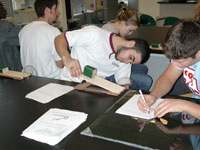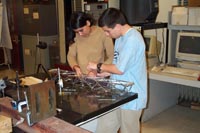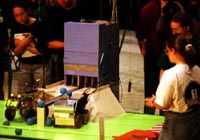
Teaching
Resources
Teaching
ME 7960 - Precision Machine Design
The course provides an intensive coverage of precision engineering theory and its application to the design of complex production equipment such as machine tools, robots, and metrology.
Topics covered include: precision design philosophy; the current state of art; principles of accuracy, repeatability, and resolution; error budgeting; sensors and sensor mounting; contact and non-contact bearings for rotary and linear motion; actuators and transmissions; structural design; dynamic response and structural damping; solid modeling of complex systems.
The course aims to help students in developing creative designs and teaches techniques that allow the designs to be optimized through analytical and numerical methods. Weekly homework assignments provide ample opportunities to practice the concepts learned. The course culminates in a final project.ME 3910 - Design Methodology, University of Utah
ME EN 3910 is the first course in the Senior Design Sequence--ME EN 3910, 4000, 4010 or ME EN 3910, 4005, 4015. The first half of the class consists of lectures leading to the team project proposal: problem identification and definition team organization, background research, idea generation techniques, needs analysis, scheduling, and budgeting. Culminates in a formal written and oral presentation of the capstone project proposal. Also scheduled are guest lectures that cover topics in intellectual property and patents, ethics, written and oral communication skills and team work.
The second half of the class is spent exploring topics in Machine Element design, such as selections of bearings, gears, fasteners, shafts, fits and tolerances, etc.ME 4000 - Engineering Design I, University of Utah
This course is the second in a three-course sequence (ME 3910, ME 4000, ME 4010). It builds directly upon ME 3910 which covered the basics of the design process such as problem definition, concept creation and selection, budgeting (time, money and resources). In ME 4000, students primarily work on the senior design projects chosen at the end of ME 3910. Students are required to meet with their team mates and project advisors on a weekly basis. At every meeting, a different member of the team gives a brief update of the project. The communications TA’s will attend the update meetings and provide the presenters with feedback.
The course is supported by mandatory lab sessions intended to strengthen the students ability to visualize, analyze and optimize various design problems. In particular, students will individually perform a series of Pro/ENGINEER based tasks that teach basic as well as advanced design capabilities. Advanced engineering analyses and design optimizations exercises will be performed using Pro/MECHANICA, Matlab and spreadsheets.Current and past projects include: Formulae SAE, Mini-Baha, Walking Robot, Solar Car, Stair Assist Cane I, Stair Assist Cane II, Minimization of Blood Sputter in Katheters, Human Powered Vehicle, AeroBar, Digital Torsion Tester, Foldable Ski, Fuel Cell, Hybrid Rocket Motor and SnoChair.
ME EN 4010 - Engineering Design I, University of Utah
ME EN 4010 is the third and final course in the Senior Design Sequence - ME EN 3910, 4000, 4010. The course is largely focused on the senior design projects and their presentation at Design Day.
Students will be able to focus on their design projects and periodically, as a team, report on the status of the project. On Design Day, students will present the projects to the public and give final presentations. At the completion of this course, students will have learned to work as a team on a complex design problem.
There will be three design reviews (see attached Table for the schedule) and one final presentation (on Design Day). The design reviews are limited to 20 minutes and need to provide a brief update on the status of the project (budget and schedule) but otherwise focus on detailed, technical aspects of the project. All team members are expected to be present and answer questions in a professional and competent manner. In case of problems in the design, team members are expected to provide approaches to solve problems in their designs.
The final presentation is limited to 10 minutes and needs to provide an overview of the project and highlight the achievements2.001 - Mechanics and Materials I, MIT
As a section instructor, I taught MIT's introductory solid mechanics course to Freshmen and Sophomores. Recitations involve an active learning style where the students explore mechanical systems often before they were covered in lecture. This increases the student's conceptual understanding of the topic by preventing the students from "rehearsing" equations.
The tools developed as part of the iCampus project play a major role in this course.
2.973 - Mechanics in Design, MIT
This is a new course for the MIT Independent Activity Period (IAP) where sophomores in the Mechanical Engineering Department simulate and optimize complex structures (truss and sandwich structures) and then build and test them for their structural properties. This course makes heavy use of the computer-based simulation tools developed by the iCampus group and is intended to act as a bridge between solid mechanics and engineering design. For more details, visit the course website as http://icampus1.mit.edu/courses/2.973/2.973.html. 2.007 - Introduction to Design and Manufacturing, MIT
During my first year at MIT, I taught (as a TA) a section in 2.007, MIT's sophomore design course, taught by my advisor, Professor Alexander H. Slocum. This course teaches hands on design and manufacturing. Students are given a kit of materials from which they must build a machine to compete in the annual MIT design contest. The following year, I was the head TA, and designed the contest, "Ballcano 1998", MIT's first active contest table.
I designed and built the conveyer systems that dispensed five street hockey balls per second over the forty second contest round.
In the following summer, I joined six of the students in travelling and competing in an international contest at the University of Sao Paulo in Brazil, in July of 1998.



